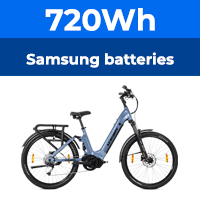Well - it is rather quiet.....

As I said - this is how I usually tell when it's done charging.
What I was refering to when I talked about concise information was not just the basic opperation, but also things like how to improve longevity & how to recondition used batteries (David from Wisper recently posted about the use of a 200ma charger to do this - I had no idea it was possible 'till then). How about some information that is not dumbed-down, and is therefore of use to the more technically minded amonst us.
As for the colour issue, I was just making a side point that is pertinent not just to me, but to a whole lot of other people (wether they know it or not), which is why I thought it worth mentioning - sorry if I
Strayed (gettit

) OT.
Well, I thought I'd been both detailed and clear in my explanation - but then I would, wouldn't I?
Longevity on any battery is helped by recharging as soon as possible after use, though it's generally considered to matter much less on most technologies than it does on SLAs, which are still in common use on ebikes and other vehicles.
Also not fully discharging before recharging helps - if your commute to and from work leaves you with very little remaining charge, it's a good idea to have a charger available at each end of the journey so you effectively halve the distance between recharges, and don't leave a battery part-charged for several hours. Once again, it's vital with SLAs, much less so with other technologies.
I'm told it's best not to fully charge a lithium ion battery, but to stop a little short of completely full. This would be hard to arrange in practice as you can't easily tell exactly how far the charge has progressed - only when it's complete. The battery BMS (Battery Management System) may well perform this function in any case. I think it's probably best practice to recharge until the BMS has had enough, as one of its functions is to keep the charge of the cells synchronized, and if you stop it short you will obviously defeat this function. See my observation on the charging behaviour of a Wisper battery, which is specifically the item on which Richard had a query.
It's hard to give much else in definitive form. Best practice not only varies with the technology, but also with the manufacturer. They may not even give you the best guidance themselves.
Lithium ion and lithium-iron-phosphate batteries always incorporate a custom BMS and the chargers are fairly dumb, usually only being designed to current limit and then give out a constant voltage within that limit. How the BMS works varies enormously and there's little information on what goes on.
In the case of nickel metal hydride batteries, there may or may not be a BMS, and the charger may be more or less smart accordingly. It's quite difficult in practice to detect a full charge on this technology - there is a small drop in voltage as charging completes, and also a rise in internal temperature which is sometimes used as a guide via a temperature sensor buried among the cells. When these batteries age one of the things that happens is that they don't hold their charge for long even though the capacity might still be quite good - to keep them working well they need to be used frequently, and to get the best range they should be freshly charged immediately before use.
In the case of SLAs there is never a BMS - the simpler chargers are current limited and then constant voltage, which means the battery comes to a gentle full charge eventually but that could take 12-24 hours. The more sophisticated chargers 'overdrive' the charging process by outputting a higher charging voltage and therefore also a higher current, but they watch for the battery voltage to rise at the end of the charging cycle and then cut back so as not to overdo it. Charging time 6-10 hours typically.
Rog.


